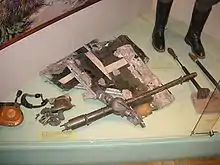Aleksander Gabszewicz | |
|---|---|
.jpg.webp) | |
| Born | 6 December 1911 Šiauliai, Russian Empire (now Lithuania) |
| Died | 10 October 1983 (aged 71) Malvern, Worcestershire, England |
| Service/ | |
| Rank | Generał brygady |
| Service number | P-0163 |
| Unit | Border Defence Corps No. 607 Squadron RAF No. 303 Polish Fighter Squadron |
| Commands held | No. 316 Polish Fighter Squadron 2nd Polish Wing 1st Polish Wing 56th USAAF Fighter Group |
| Battles/wars | Second World War |

Aleksander Klemens Gabszewicz (6 December 1911 – 10 October 1983) was a Polish fighter pilot and a World War II fighter ace, with a score of 9½ confirmed and 2 probable kills.
Biography
Born in Šiauliai, then in the Russian Empire (now Lithuania), in 1931 he joined the Polish Army. Initially serving as an infantry NCO, in 1938, he graduated from the Dęblin-based Eagles' School and was attached to the air wing of the Border Defence Corps. Just before World War II he was a tactical officer of the IV/1 Fighter Group.[1]
After the outbreak of the Polish September Campaign on 1 September 1939, around 9 AM, he scored his first kill, a Heinkel He 111 of 5.(K)/LG 1 unit over Ciechanów.[2] According to some authors, it was the first kill of a German plane in World War II.[3]
Downed the same day, he made it to France where he became the commanding officer of the 5th key of Groupe de Chasse III/10 covering Besançon.[4] There, while piloting a Bloch 151, he downed a Dornier Do 17.[5]
After the capitulation, he made it to the United Kingdom, where he served in the ranks of No. 607 Squadron RAF and No. 303 Polish Fighter Squadron.[6] In December 1940 he was posted as a flight commander in No. 316 Polish Fighter Squadron. He became the commanding officer in November 1941.[7] He was posted to 11 Group HQ in June 1942, and then as an instructor to 58 OTU until June 1943. He was then made wing commander/flying of the 2nd Polish Wing and finally the 1st Polish Wing. He was also attached to the 56th USAAF Fighter Group in December 1943, and then commanded 131 Wing RAF in February 1944, leading the wing during the invasion of Normandy. He became the commanding officer of RAF Coltishall in February 1945.[8]
He ended the war in the Polish rank of generał brygady and remained in exile in the United Kingdom. He died in Malvern in 1983. His ashes were brought to Poland in 1992 and dispersed over Warsaw and Dęblin.[1]
Legacy
The Battle of Britain Memorial Flight's Spitfire TE311 is painted to represent the aircraft flown by Gabszewicz in Germany from April to June 1945.[9]
Decorations
 Distinguished Service Order (with Bar)
Distinguished Service Order (with Bar) Distinguished Flying Cross
Distinguished Flying Cross Croix de Guerre (France)
Croix de Guerre (France) Virtuti Militari (Golden Cross)
Virtuti Militari (Golden Cross) Virtuti Militari (Silver Cross)
Virtuti Militari (Silver Cross) Commander's Cross with Star of the Order of Polonia Restituta
Commander's Cross with Star of the Order of Polonia Restituta_4r_BAR.PNG.webp) Cross of Valour, four times
Cross of Valour, four times
References
- (in Polish) Short biography
- (in Polish) extended biographical note at Myśliwcy web page
- Aleksander K. Gabszewicz
- Citations
- 1 2 Krzystek 2012, p. 185.
- ↑ Sikora 2014, p. 200.
- ↑ Marius Emerling: Pierwszy zestrzał w kampanii wrześniowej 1939 r. – Mit ppor.pil. Władysława Gnysia in: Lotnictwo Wojskowe Nr.5/2002 (in Polish)
- ↑ Belcarz 2012, p. 8.
- ↑ Aces High, Shores & Williams 1999, page 272
- ↑ Zieliński 1994, p. 20.
- ↑ Zieliński 2005, p. 50.
- ↑ Zieliński 2005, p. 51.
- ↑ "BBMF Spitfire TE311 is 75!". memorialflightclub.com. Retrieved 17 September 2021.
- Bibliography
- Tadeusz Jerzy Krzystek, Anna Krzystek: Polskie Siły Powietrzne w Wielkiej Brytanii w latach 1940-1947 łącznie z Pomocniczą Lotniczą Służbą Kobiet (PLSK-WAAF). Sandomierz: Stratus, 2012, p. 185. ISBN 978-83-61421-59-7
- Piotr Sikora: Asy polskiego lotnictwa. Warszawa: Oficyna Wydawnicza Alma-Press. 2014, pp. 199–208. ISBN 978-83-7020-560-7
- Zieliński, Józef (1994). Asy polskiego lotnictwa (in Polish). Warsaw: Agencja Lotnicza ALTAIR. p. 20. ISBN 83-86217-2. LCCN 95149065. OCLC 34751125. OL 865104M.
{{cite book}}: CS1 maint: ignored ISBN errors (link) - Józef Zieliński: Lotnicy polscy w Bitwie o Wielką Brytanię. Warszawa: Oficyna Wydawnicza MH, 2005, pp. 50–51. ISBN 978-83-906620-4-6